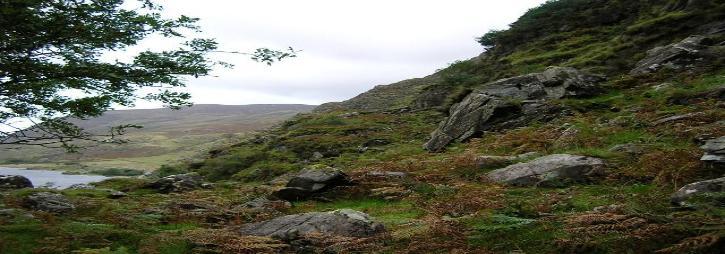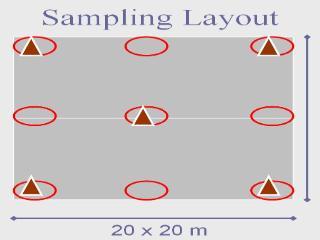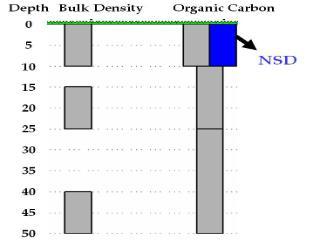Soil Carbon Project
Soil Carbon Project

About The Project
Soil organic carbon is of both local and global importance. Locally, it is an essential component of soil organic matter. Globally, soil organic carbon is an import potential sink of carbon dioxide. Past research concerning soil organic carbon in Ireland has focused on its role in the agricultural environment. Only in the past decade has work been done to quantify and understand the spatial trends of soil organic carbon. This work has relied on disparate sources and adhoc data and a well replicated study investigating soil organic carbon in relation to land use, soil type, precipitation and topography is needed. Focusing this study on the distribution of soil carbon within the top meter of the soil profile will add greatly to the knowledge and understanding of soil organic carbon in Irish soils.
SoilC is a two year project to estimate soil carbon stocks in representative Irish soils (by field sampling and laboratory soils analysis) and to model soil carbon cycling in Irish grassland in order to estimate the potential for carbon sequestration in Irish grassland soils under contemporary and future management and climatic conditions.
SoilC runs in parallel with CréBeo, a national study of soil biodiversity in Ireland. Both projects use the same sites.
Workpackages
- Literature review
- National scale soil organic carbon stocks
- Farm level soil organic carbon analysis
- Detectability of carbon stock changes using soil sampling
- Integration of farm level soil organic carbon data into soil organic matter models
- Analysis of findings in context of UNFCCC and Kyoto Protocol
- Final report
An additional task is to measure dissolved organic carbon in surface waters at a national scale.
Project Staff
Principal Investigator - UCC
Prof. Ger Kiely
Research Co-ordinators - Teagasc
Owen Carton, Teagasc, Johnstown Castle Estate, Wexford
Deirdre Fay, Teagasc, Johnstown Castle Estate, Wexford
Research Assistants
Dr. Paul Leahy, UCC
Mr. James Eaton, UCC
Ms. Nicola McGoff, UCC
James Eaton is a research assistant with the Centre for Hydrology, Micrometeorology and Climate Change. His background is in the fields of terrestrial ecology, botany, biogeochemistry and soil biology. Before coming to University College Cork, James was a Fulbright Scholar at the Agricultural University of Krakow in Poland. There he used remotely sensed data in conjunction with field surveys of vegetation to investigate the causes and consequences of land-use change in Polish forests. He holds a M.S. degree from the University of Virginia.
Nicola McGoff holds a Bachelor of Science degree from Portland State University in Geology and Environmental Sciences, and a Masters of Science from the University of Virginia. Her masters’ research investigated “The role of the grasshopper Orchelimum fidicinium in salt marsh ecosystems”. In her last position, Nicola worked as a research assistant in the Department of Biology at West Virginia University examining “The role of forested floodplain ecosystems in the southeastern United States on P cycling”.
Steering Commitee/Funding
Steering Commitee
Peter Loveland
Cranfield University, UK.
John Scullion
University of Wales, UK.
Funding
This project is funded under the Environmental Protection Agency's ERTDI research programme in Land use, soils and transport.
Sites and Methods
Sites
Soil samples were collected at 62 locations throughout Ireland. These 62 locations were chosen randomly from the 1310 National Soils Database grid using a computer program. These sites covered five land use types (i.e. arable, bog, forest, grassland and rough) and ten soil types. These soils represent over 98% of all Irish soils. The sites sampled are considered representative of the major land uses and soil types throughout Ireland with an unbiased (naturally occurring) geographic spread.
Field Methods
Sampling sites were located in the field using the GPS co-ordinates given by the NSD and a hand held GPS. The data point was centrally located within our plot. At each site a 20 x 20 m square was laid out on a north-south central axis. Photographs were taken in all directions. Elevation was recorded. Land use was described, as well as vegetation and soil profiles. Any land use history discussed and discovered at the site was recorded.
At each site bulk density and soil organic carbon was collected. Bulk density was collected at 5 points, the corners and centre of the square. We used a fixed volume bulk density sampling ring, 5cm deep and 8cm diameter. At each bulk density point 6 depths were collected, 0–5, 5–10, 15–20, 20–25, 40–45, and 45–50 cm. Soil organic carbon (SOC) was collected at 9 points on the square. We used a half inch Dutch auger. Soils were collected for a continuous profile from the surface to 50 cm deep broken in the following sections: 0–10cm, 10–25cm and 25–50cm deep. The figures below illustrates the field sampling scheme.
Sampling Layout

Sampling Depths
Soil Properties
Bulk density and organic carbon content
In order to determine the total organic carbon stock of a soil it is necessary to measure both the organic carbon concentration and the bulk density of the soil.
In SoilC, both of these soil properties are measured to a depth of 50 cm, so that the total soil carbon stock of the top 50 cm of soil can be calculated
Both, organic carbon and bulk density are influenced by land use and soil type.
Bulk density profile for several land uses in ireland

Bulk Density profile of irish soils


